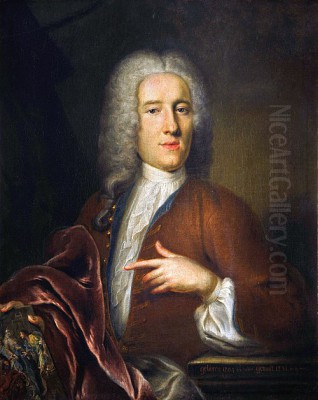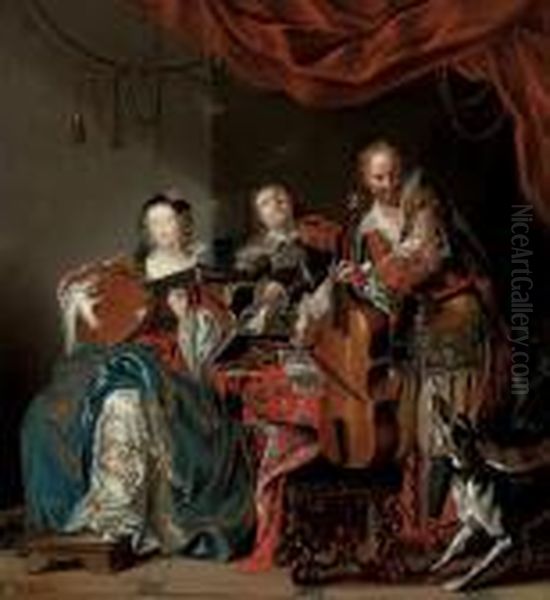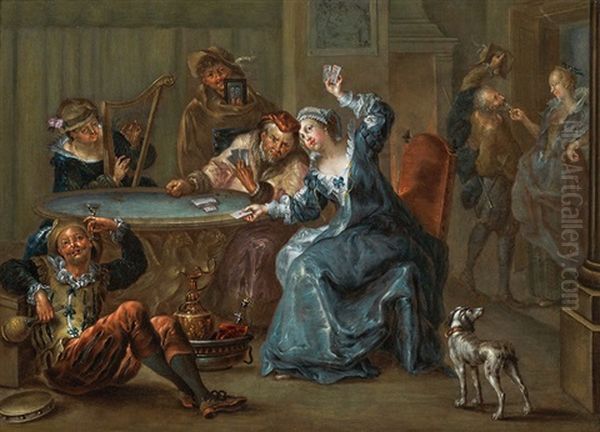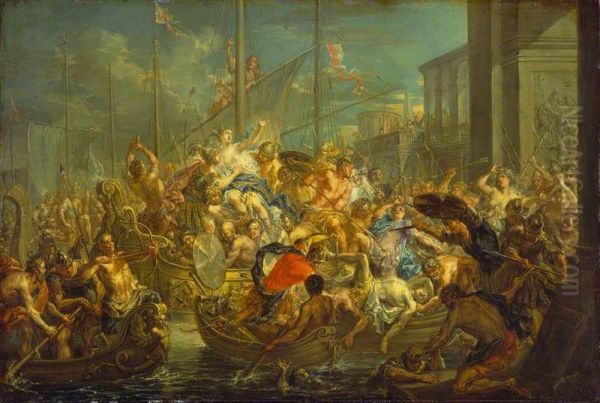
Johann Georg Platzer stands as a significant figure in the Austrian art scene of the 18th century. Born in 1704 and passing away in 1761, his life spanned a vibrant period of artistic transition and flourishing, particularly in Vienna, the heart of the Habsburg Empire. Platzer carved a distinct niche for himself as a master of the Rococo style, specializing in exquisitely detailed cabinet paintings that captured the elegance, mythology, and intimate social life of his era. Though sometimes overshadowed by painters working on a grander scale, Platzer's meticulous technique, luminous colours, and charming subjects earned him considerable acclaim during his lifetime and secure his place in the annals of art history.
Early Life and Artistic Formation in Tyrol and Passau
Johann Georg Platzer was born into an artistic milieu in Eppan (Appiano sulla Strada del Vino), a town nestled in the South Tyrol region, then part of the Austrian Habsburg lands. His birth year is firmly established as 1704. The Platzer family had a notable tradition of painting, providing Johann Georg with an environment steeped in artistic practice from his earliest years. His father, Johann Victor Platzer, was a painter, setting the stage for his son's future profession.
His initial formal training came under the guidance of his stepfather, Josef Anton Kessler, who was also active as a painter in the region. This early instruction likely grounded him in the fundamentals of drawing and painting prevalent in the Tyrolean area, which often blended local traditions with influences from nearby Italy and Germany. Seeking broader horizons and more advanced training, Platzer later moved to Passau, a prominent city in Bavaria.
In Passau, he continued his artistic education under the tutelage of his uncle, Christoph Platzer. Studying with a relative who was an established painter would have provided both technical instruction and valuable insights into the workings of the art world beyond his immediate home region. This period in Passau further honed his skills and likely exposed him to different stylistic currents circulating in Southern Germany.
The Move to Vienna and Academic Studies

Around 1726, seeking the opportunities available in the imperial capital, Johann Georg Platzer relocated to Vienna. This move marked a pivotal moment in his career. Vienna, at this time, was a major European cultural centre, bustling with artistic activity under emperors like Charles VI and later Maria Theresa. The prevailing taste was shifting from the grandeur of High Baroque towards the lighter, more intimate, and decorative Rococo style.
Platzer enrolled in the prestigious Academy of Fine Arts Vienna (Akademie der bildenden Künste Wien). This institution was a crucible for artistic talent in the Habsburg lands. During his time at the Academy, he would have been exposed to rigorous training based on drawing from casts, live models, and studying the works of established masters. A key figure at the Academy during this period was Jacob van Schuppen, a painter of French origin who served as its director for many years and influenced its curriculum and artistic direction. Studying within this environment provided Platzer with advanced technical skills and a deeper understanding of art theory and history.
It was also in Vienna, likely through the Academy or the city's close-knit artistic circles, that Platzer formed a significant friendship with Franz Christoph Janneck. Janneck was another painter specializing in small-scale genre and historical scenes, working in a style often comparable to Platzer's. Their association suggests a shared artistic sensibility and potentially mutual influence, contributing to the development of the characteristic Viennese Rococo cabinet painting style. Even before his Vienna period, Platzer demonstrated considerable promise, completing an altarpiece for the Church of St. Helena in Deutschnofen (Nova Ponente) back in South Tyrol in 1724.
The Emergence of a Distinctive Rococo Style
Platzer rapidly absorbed the influences surrounding him in Vienna and synthesized them into a highly personal and recognizable style. He became one of the foremost practitioners of the Rococo in Austria, particularly renowned for his cabinet paintings – small, finely wrought pictures intended for close viewing in private collections or intimate domestic settings (Kabinettstücke).
His style is characterized by meticulous attention to detail, reminiscent of the Dutch fijnschilders ("fine painters") of the 17th century, such as Gerard Dou and Frans van Mieris the Elder. Every element, from the texture of fabrics and the gleam of metal to the expressions on figures' faces, is rendered with painstaking precision. This detailed approach was combined with the elegance, lightness, and playful spirit characteristic of the French Rococo, associated with artists like Antoine Watteau and François Boucher.

Platzer's compositions are often complex, featuring numerous figures engaged in various activities within richly decorated interiors or idyllic landscapes. He possessed a remarkable ability to orchestrate these crowded scenes with clarity and dynamism. His colour palette is typically bright, luminous, and jewel-like, contributing to the overall sense of opulence and refinement. He often favoured painting on copper panels, a support that provided an exceptionally smooth surface ideal for his detailed technique and which enhanced the brilliance and luminosity of his oil colours.
Influences from Flemish Baroque masters like Peter Paul Rubens and David Teniers the Younger can also be discerned, particularly in the lively depiction of figures and sometimes in the choice of peasant or genre themes, albeit elevated to a more courtly level of elegance. He also drew upon Italian artistic traditions, reflecting the enduring impact of Italian art across Europe. Platzer masterfully blended these diverse sources – Dutch precision, Flemish energy, French elegance, and Italian composition – into a unique Viennese Rococo idiom.
Themes and Subject Matter: Mythology, History, and Elegant Society
Johann Georg Platzer's oeuvre encompasses a range of subjects popular during the Rococo period, reflecting the tastes of his patrons, who likely included members of the aristocracy and the increasingly wealthy bourgeoisie. He excelled particularly in depicting scenes from classical mythology, history, and the Bible, often choosing moments rich in narrative potential and opportunities for elaborate display.
Mythological subjects allowed Platzer to explore dramatic narratives and depict the human form in various states, often within opulent settings. Tales involving gods, goddesses, heroes, and nymphs were favourites, providing scope for both sensual beauty and moral allegory. Works depicting themes like Samson and Delilah or Bathsheba at her Bath combined biblical narrative with an exploration of human drama and the allure of the figure.
Historical scenes, often drawn from ancient Roman or Greek history, were also part of his repertoire. A notable example is Curius Dentatus Refusing the Gifts of the Samnite Ambassadors, a subject extolling Roman virtue and incorruptibility, which allowed for the depiction of contrasting figures and rich diplomatic gifts. Such themes appealed to the era's interest in classical antiquity and moral exemplars.
Perhaps most characteristic are Platzer's genre scenes, often referred to as "conversation pieces" or depictions of fêtes galantes (elegant outdoor parties). These paintings capture the leisured activities of the upper classes: musical concerts, card games, elaborate meals, dancing, and flirtatious encounters in sumptuously decorated interiors or lush garden settings. These works provide a fascinating glimpse into the social rituals and refined atmosphere of 18th-century Viennese society. Examples like Elegant Company Making Music or Card Players epitomize this aspect of his work.

Platzer also painted allegorical series, such as depictions of the Four Elements, the Four Seasons, or the Five Senses. These allowed him to create visually rich compositions filled with symbolic details. Furthermore, he produced intriguing scenes set within artists' studios, offering a self-reflexive look at the world of art creation itself, sometimes featuring the artist surrounded by models, pupils, patrons, and the tools of his trade, as seen in works titled The Artist's Studio or Allegory of Painting.
Masterworks and Signature Pieces
While attributing specific titles can sometimes be complex due to variations in inventories and translations, several works are consistently recognized as representative of Platzer's skill and style. His paintings are often identifiable by their small scale, copper support, intricate detail, and vibrant colours.
Elegant Company Making Music (various versions exist) showcases his ability to depict refined social gatherings. Figures in fashionable attire are shown playing instruments, singing, or listening intently within richly appointed rooms. The textures of silk, velvet, lace, and polished wood are rendered with extraordinary fidelity.
The Four Elements and The Four Seasons are allegorical series where Platzer used complex arrangements of figures, animals, and symbolic objects to represent abstract concepts. These works demonstrate his compositional skill and his ability to integrate numerous details into a coherent whole, often imbued with a sense of dynamic energy.
Biblical and mythological scenes like Samson and Delilah, Bathsheba at her Bath, or The Finding of Moses highlight his narrative abilities and his skill in depicting dramatic moments and human emotions, often set against elaborate architectural or landscape backgrounds.
Curius Dentatus Refusing the Gifts of the Samnite Ambassadors is a prime example of his history painting, showcasing his ability to handle complex multi-figure compositions and convey a moral message through historical narrative. The contrast between the simple Roman general and the lavishly dressed Samnite envoys bearing treasures is effectively portrayed.
Works depicting The Artist's Studio or allegories of the arts (like Allegory of Painting or Allegory of Sculpture) are particularly interesting. They often feature a bustling scene filled with sculptures, paintings, drawings, and numerous figures, celebrating the creative process and the status of the artist. These paintings are valuable documents of how artists perceived their own profession during the period.
Many of his works, regardless of specific title, share common characteristics: crowded compositions, dynamic figure arrangements often in swirling or diagonal patterns, meticulous rendering of surfaces and textures, a bright and varied colour palette, and an overall atmosphere of lively elegance or dramatic intensity, all executed on a small, intimate scale.
Technique: The Art of the Fijnschilder on Copper

A crucial aspect of Platzer's artistry lies in his technique, particularly his preference for painting on copper panels. This choice of support was not unique, but Platzer exploited its properties to maximum effect. Copper provides a perfectly smooth, non-absorbent surface, unlike canvas or wood panels. This allowed him to achieve an exceptionally high level of detail and a smooth, enamel-like finish.
His brushwork was incredibly fine and precise, enabling the meticulous rendering of intricate patterns on clothing, the delicate features of faces, the complex details of architecture, and the varied textures of objects. This detailed approach aligns him with the tradition of the Dutch fijnschilders. The non-absorbent nature of the copper also meant that the oil paint sat on the surface, retaining its brilliance and luminosity to a greater degree than on more porous supports. This contributes significantly to the jewel-like quality of his colours.
Platzer's application of paint was careful and layered, building up forms with subtle gradations of tone and colour. His understanding of light and shadow was sophisticated, allowing him to create convincing illusions of depth and volume even within crowded compositions. The interplay of light across different surfaces – shimmering silk, dull metal, soft flesh – is often a key feature of his paintings' appeal.
While primarily known as a painter, the initial information also mentions him as a printmaker or etcher. Although less emphasized than his paintings, his activity in printmaking would align with the era's practices, where artists often disseminated their compositions or created independent works through etching or engraving. His detailed drawing style would have translated well to the linear demands of printmaking.
Later Years, Illness, and Return to Tyrol
Johann Georg Platzer enjoyed considerable success during his main working period in Vienna. His detailed and elegant cabinet paintings were sought after by collectors who appreciated their refinement and technical brilliance. However, his prolific career was impacted by health problems later in life. Sources consistently mention that he suffered a stroke, or possibly a palsy or tremor ("Zitterschlag"), which significantly affected the use of his right hand, his painting hand.
This debilitating condition made the meticulous execution required by his style increasingly difficult. Consequently, around 1755, Platzer decided to leave the bustling artistic centre of Vienna and return to his native South Tyrol. He settled back in or near his hometown of Eppan. Despite the physical challenges he faced, it is believed that he continued to work to some extent, perhaps adapting his technique or relying more on studio assistants, though his output likely diminished in quantity and perhaps in finesse.
Johann Georg Platzer passed away in Eppan in 1761, bringing an end to the life of one of Austria's most distinctive Rococo masters. He died in the region where his artistic journey had begun, after achieving significant recognition in the imperial capital.
Legacy and Position in Art History
Johann Georg Platzer holds a secure place in Austrian art history as a leading exponent of the Rococo style, particularly in the specialized genre of the cabinet painting. His works epitomize the elegance, refinement, and intimate scale favoured by many patrons during the mid-18th century. His technical virtuosity, especially his meticulous detail and masterful use of copper supports, remains remarkable.
He was part of a vibrant Viennese art scene that included other notable Rococo and late Baroque painters such as Paul Troger, known for his large-scale frescoes and altarpieces; Daniel Gran, another master of monumental ceiling painting; and later, Martin Johann Schmidt, often called "Kremser Schmidt," whose style evolved towards a more expressive, looser manner. Platzer, along with his friend Franz Christoph Janneck, represented a specific, highly refined trend focused on small-scale, detailed works for private enjoyment.
Platzer's influence extended to pupils, such as Johann Michael Püchler, who continued working in a similar style, demonstrating the appeal of Platzer's approach. His paintings were collected not only within the Habsburg Empire but also found their way into collections across Europe, including Russia, Poland, and Germany, attesting to his international reputation during his lifetime and shortly thereafter.
While some later art historical narratives, perhaps favouring grander formats or different aesthetic ideals, may have given less prominence to cabinet painters like Platzer, his work has consistently been appreciated by connoisseurs and museums. Today, his paintings are held in major institutions worldwide, including the Belvedere Palace and the Kunsthistorisches Museum in Vienna, the Alte Pinakothek in Munich, the Hermitage Museum in St. Petersburg, and numerous other public and private collections.
His art offers a captivating window into the aesthetic sensibilities and social life of the Rococo era in Central Europe. The combination of technical brilliance, charming subject matter, and vibrant execution ensures Johann Georg Platzer's enduring appeal and his significance as a master of the intimate scale. His dedication to detail and the sheer visual delight offered by his jewel-like paintings continue to fascinate viewers centuries after their creation.